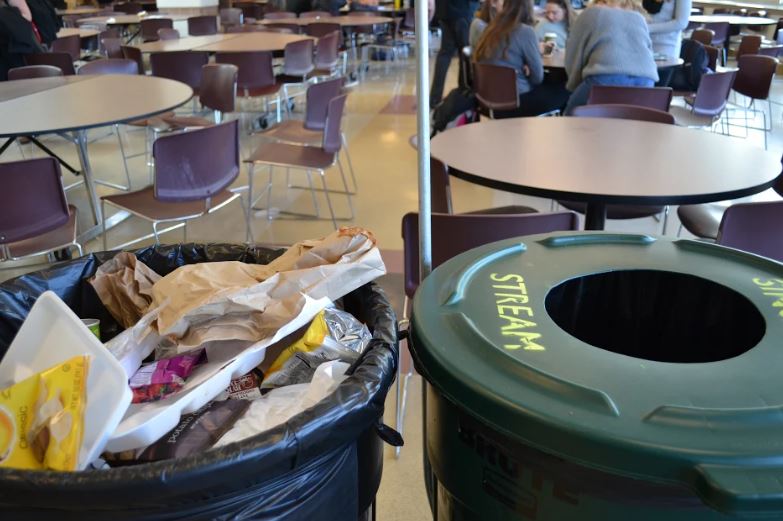Pay more attention to recycling to reduce waste
By second lunch, cafeteria trash cans fill to the brim with wastes while the Single Stream recycling bin is nearly untouched.
February 18, 2019
On the first days of school, when everyone is caught up with trying to get to and from class, reconnecting with old friends and being bombarded with countless course expectations, the last thing most of us pay attention to is how to use the Single Stream.
Our school has made efforts to accomplish environmental goals by putting Single Stream bins into classrooms, yet the majority of students do not know how to use them. During the 45 minute blur of teachers preaching their overview for the year, they might spend less than one minute talking about three different waste bins in each classroom that all end up being used as trash bins a week later.
One bin, usually blue, is primarily for the white paper. Another bin is for trash including food wrappers, scraps, tissues and gum. Lastly, the green bin is for Single Stream for recyclables such as plastic water bottles, colored paper and cardboard. If trash gets mixed in with recyclables, all of the products in that bin are contaminated and have to go to the trash.
If our school wants to produce less waste, we have to be effectively informed about programs implemented inside these walls. The sign that hangs above the three waste bins does not do justice to the importance of using the correct bin. It does not effectively inform. It just adds confusion.
The sign has images of waste with the words “Single Stream,” “Trash” and “Recycle”. There is no clear separation between the groups displayed on the sign. It does say what goes in Single Stream.
To fix these problems, we should call “Single Stream” recycle. Most people are more familiar with that term and simply changing the name would help eliminate much of the confusion.
However, even if we know how to use the bins, sometimes we do not care enough to put our recyclable products in the Single Stream or white paper in the blue bin.
By third lunch, our trash cans are overflowing with plastic bags and styrofoam trays. One lunch, I witnessed the trash can near one of the exits spilling over with trash, and as students walked out, they threw their plastic bags, banana peels and trays in the Single Stream. All of the correctly sorted waste had to go in the trash rather than the recycle bin.
This problem is not on maintenance staff, but on every person at this school. Together we need to change the way we view our waste habits and form effective plans of action.
Whether it is an honest mistake or pure carelessness, our waste does not go into the correct bins and as a community, we need to take responsibility for this problem.
According to Facilities Director Michael Gorman, before Single Stream, waste removal efficiency 55 percent. After Single Stream was implemented into our school, the waste removal efficiency increased to 85 percent. But now, in later years, waste removal efficiency has gone down to 75 percent due to carelessness.
Gorman and other members of the facilities team are striving to help our school be more environmentally responsible. They recently received a grant for $10,000 and the majority of the money is being put towards Ergonomic Equipment, which will help our school burn fuel more efficiently to save money and be more environmentally friendly.
We need more efforts like these to become more environmentally friendly. The Single Stream started off as an effective program that helped reduce our waste. If we decide not to become less careless, then a call for a more effective idea to reduce waste is needed.
It is up to us to change our school for the better. Together, we need to find ways to reduce our everyday waste.
For example, a problem that we need to address is the styrofoam trays used for lunches. Economically, Gorman said that the styrofoam trays were better for the tight budget, yet environmentally they damage the Earth because styrofoam can never be broken down in landfills.
Our school should find an alternative way to sell lunches, but pricing for reusable trays and a machine to wash them is not in the budget, according to Gorman. The school can hold fundraisers or clubs can support this cause, so we can raise the money to carry this out.
It is up to you and me to start caring for this world we will be given to explore after these four years. Let us start by changing the place that will teach us how to explore it.










